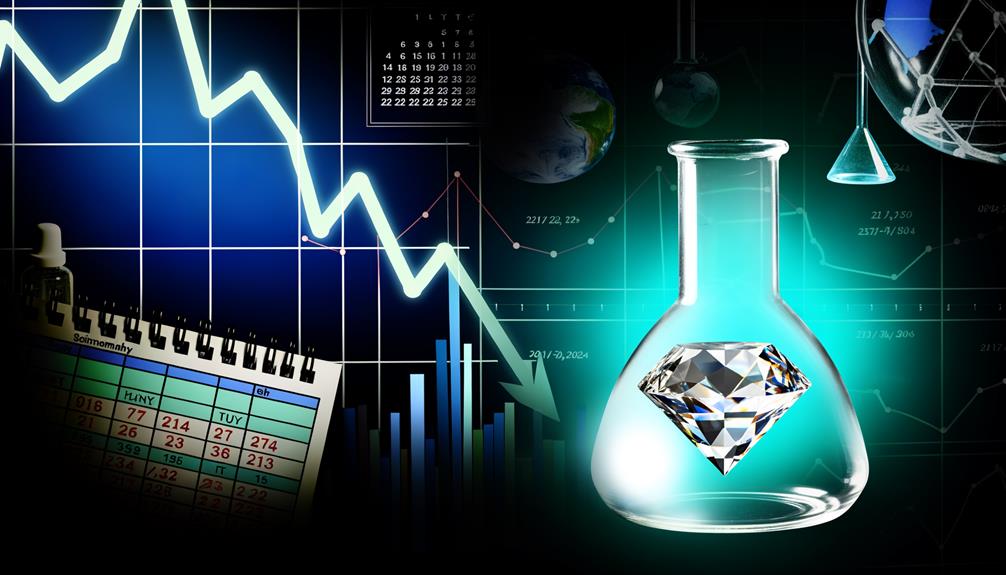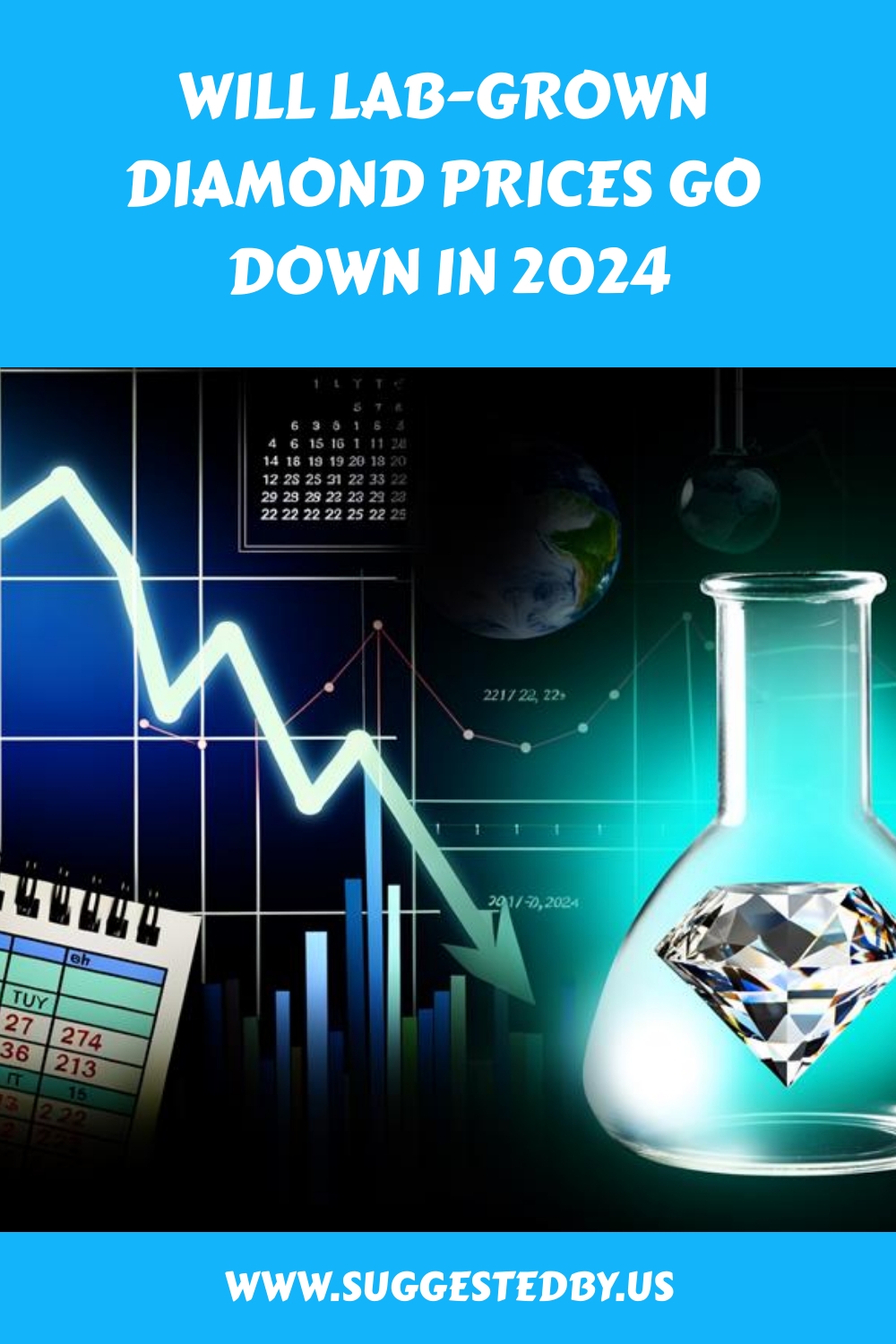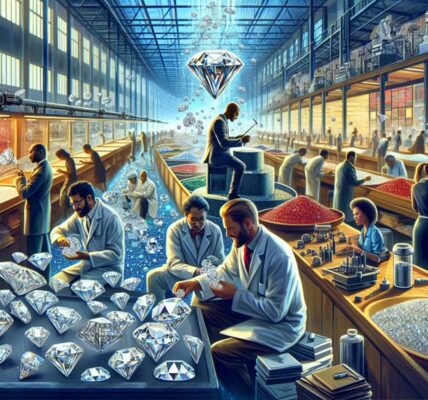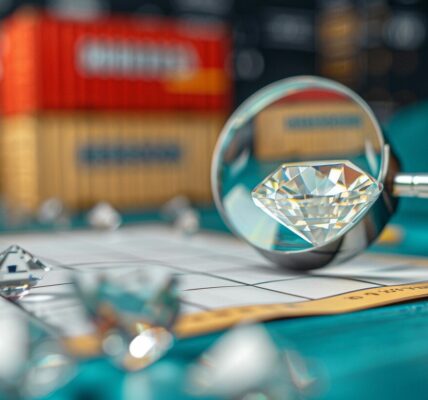The lab-grown diamond industry is at a crossroads as we approach 2024. With a significant 37% price reduction in the past year, compared to a less pronounced 19% drop in natural diamond prices, critical questions arise about the future pricing trajectory of lab-grown diamonds. Factors such as production costs, technological advancements, and competitive market dynamics play a pivotal role in shaping this landscape. Additionally, De Beers’ recent decision to slash prices by 10% adds another layer of complexity. This analysis aims to dissect these variables and project whether the downward pricing trend will persist, stabilize, or reverse in the coming year. It offers insights into the evolving dynamics of the lab-grown diamond market.
Article Contents
- 1 Key Takeaways About Lab-Grown Diamond Prices in 2024
- 2 Understanding Lab-Grown Diamonds
- 3 Eco-Friendly Aspects Examined
- 4 Reasons Behind Price Declines
- 5 Resale Value Considerations For Lab-grown Diamonds
- 6 2024 Market Predictions
- 7 Choosing Sustainable Engagement Rings
- 8 Frequently Asked Questions
- 9 Our Conclusions About Lab-Grown Diamond Prices Through 2024
Key Takeaways About Lab-Grown Diamond Prices in 2024
- Advances in technology and increased market competition could lead to lower production costs and prices for lab-grown diamonds in 2024.
- Strategic positioning of lab-grown diamonds as affordable alternatives suggests a trend towards price reduction to attract conscientious consumers.
- The growing consumer preference for sustainable and ethical choices, including lab-grown diamonds, may drive demand, influencing prices to become more competitive.
- The volatile market situation of lab-grown diamonds and evolving perceptions could result in fluctuating prices, potentially lowering them in 2024.
Understanding Lab-Grown Diamonds
Lab-grown diamonds, synthesized through advanced technological processes, mirror the natural diamond growth method, offering identical chemical compositions, crystal structures, and physical attributes. This revolutionary development in the diamond industry has led to the emergence of man-made diamonds as a significant segment within the market, challenging the traditional paradigms of the diamond industry.
The lab-grown diamond market has witnessed a dynamic shift in lab-grown diamond prices over the past year, with a notable decrease exceeding 37%. This price reduction contrasts with the less severe decline in the cost of natural diamonds, which fell by less than 19% during the same timeframe.
Production costs and the level of competition within the industry contribute to the fluctuation of lab-grown diamond prices. As technological advancements continue to evolve, the efficiency of producing lab-grown diamonds will improve, potentially leading to further price reductions.
However, De Beers’ recent decision to lower its prices by 10% in its first sale of 2024 introduces an element of uncertainty regarding future price trends. This adjustment may influence the broader lab-grown diamond market, prompting industry stakeholders to monitor developments closely as they unfold.
Eco-Friendly Aspects Examined
Exploring the eco-friendly attributes of lab-grown diamonds reveals a complex interplay between reduced resource usage and the environmental cost of production. These diamonds demand lesser natural resources and exhibit a lower environmental footprint than their mined counterparts, positioning them as a sustainable alternative within the jewelry industry. However, the energy-intensive production process, coupled with significant water usage, injects a layer of complexity into their eco-friendly narrative. Despite these challenges, lab-grown diamonds are generally considered more eco-friendly due to their relatively lower impact on the planet.
This nuanced eco-friendliness has become a pivotal factor driving consumer interest towards lab-grown diamonds, as buyers increasingly prioritize sustainable and ethical choices. The shift in consumer preferences is reflected in the pricing dynamics of the market. While the prices and resale value of lab-grown diamonds have experienced fluctuations, the ongoing demand for eco-friendly options could influence lab-grown prices in a significant manner. As the jewelry industry continues to evolve, the balance between eco-friendliness and economic considerations will likely play a critical role in shaping the future trajectory of lab-grown diamond prices.
Reasons Behind Price Declines
While the eco-friendly attributes of lab-grown diamonds have garnered notable consumer interest, it is important to examine the underlying reasons for the notable decrease in their prices over the past year. The shifting landscape of the lab-grown diamond market can be attributed to a combination of factors that have collectively influenced the downturn in prices, enhancing the affordability and accessibility of these gems.
To create a clear picture, consider the following key reasons:
- Production Cost Efficiencies: Advances in technology have streamlined the production process for lab-grown diamonds, reducing manufacturing costs. This reduction in expenses has been passed on to consumers, contributing to the overall price decline.
- Market Dynamics: The lab-grown diamond sector has seen increased competition, with more players entering the market. This heightened competition has driven prices down as companies aim to capture market share by appealing to cost-conscious consumers.
- Affordability: The resultant price decline has made lab-grown diamonds more accessible to a broader audience. The difference in price, when compared to natural diamonds, has positioned lab-grown alternatives as an attractive option for consumers seeking value without compromising on quality.
These factors combined have reshaped the market dynamics, offering consumers the freedom to choose high-quality diamonds at more affordable prices.
Resale Value Considerations For Lab-grown Diamonds
Considering the dynamic nature of the lab-grown diamond market, the resale value of these gems is anticipated to be considerably lower than their initial purchase price. This expectation stems from recent trends indicating significant price drops in the lab-grown diamond sector, with a notable 37% decrease over the past year. Unlike their natural counterparts, which saw a less pronounced decline in value, lab-grown diamonds are facing a more volatile market situation. Market analysts predict further price drops in 2024, which could exacerbate the disparity in resale value between lab-grown and natural diamonds.

The decreasing price trends and the evolving perception of these diamonds as alternatives to natural ones influence the resale value of lab-grown diamonds. This shift may impact potential sellers who are considering the resale value as a critical factor in their decision-making process. The increasingly competitive production landscape and subsequent price adjustments, such as the 10% reduction by De Beers, underscore the challenges facing the resale value of lab-grown diamonds. Buyers and sellers alike must navigate these market dynamics carefully, with an understanding that lab-grown diamonds may not retain value to the same extent as natural diamonds.
2024 Market Predictions
Given the current trends and data analysis, market forecasts for 2024 indicate a likely continuation of the downward trajectory in lab-grown diamond prices. This projection is grounded in the substantial over 37% decrease observed in the past year, underscoring a significant shift in the industry’s pricing dynamics. Analysts expect that lab-grown diamonds offer a viable and increasingly accessible alternative to natural diamonds, further driving the anticipated price reductions.
The competitive landscape within the lab-grown diamond sector is intensifying, exerting downward pressure on prices. As production methods become more efficient and cost-effective, the savings are likely to be passed on to consumers, reinforcing the trend towards lower prices.
The forecast for 2024 suggests that the market will continue to see a strategic positioning of lab-grown diamonds as a more affordable option, without compromising on quality or appeal.
Choosing Sustainable Engagement Rings
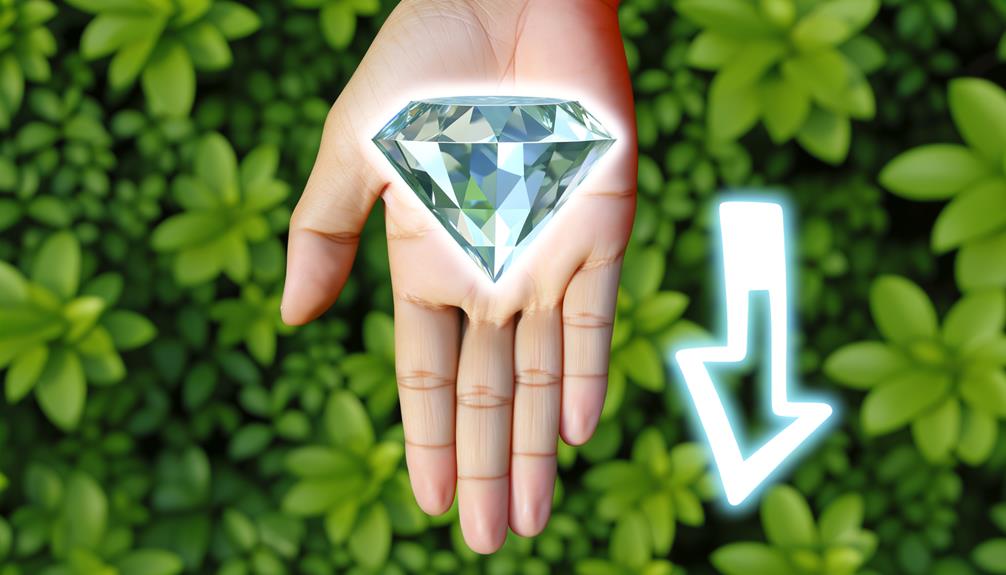
Amid the evolving landscape of the lab-grown diamond market, a notable shift towards sustainable engagement rings has emerged, reflecting consumer preference for ethical and environmentally friendly options. Consumers’ widespread desire to support ethical practices that lessen the environmental impact of conventional diamond mining is what is driving this trend. As a result, sustainable engagement rings featuring lab-grown diamonds are becoming increasingly popular choices for those looking to make a conscientious decision in their jewellery purchases.
- Environmental Impact: Lab-grown diamonds are produced in a controlled environment, reducing the ecological damage caused by traditional diamond mining processes. This method guarantees a smaller carbon footprint and less disruption to ecosystems.
- Ethical Sourcing: Choosing engagement rings with lab-grown diamonds supports a market that is free from the ethical concerns associated with conflict diamonds. This aligns with a growing consumer demand for transparency and moral integrity in their purchases.
- Quality and Beauty: Despite their sustainable credentials, lab-grown diamonds do not compromise on the quality or aesthetic appeal. They possess the same physical and chemical properties as mined diamonds, offering brilliance and durability in engagement rings.
This analytical approach highlights that sustainable engagement rings not only cater to ethical and environmentally conscious choices but also offer a freedom of choice without compromising on beauty or quality.
Frequently Asked Questions
Will the Value of Lab Diamonds Go Down?
Analyzing the current trajectory and market dynamics, the value of lab-grown diamonds is anticipated to experience a downward trend. This projection is underpinned by a notable decline over the past year and competitive pressures within the industry, evidenced by De Beers’ recent price adjustment.
Factors such as production costs, market saturation, and consumer demand will play critical roles. Consequently, potential buyers may benefit from lower prices as the industry evolves.
Will Diamond Prices Go up in 2024?
The question of whether diamond prices will increase in 2024 hinges on several factors, including market demand, production costs, and global economic conditions.
Historical data indicates a significant fluctuation in prices, particularly for lab-grown diamonds, which have seen over a 37% drop in the past year.
With De Beers reducing prices by 10% in their first sale of 2024, the trend suggests potential stabilization, but the market remains unpredictable.
Will Lab-Grown Diamonds Keep Getting Cheaper?
Analyzing the trajectory of lab-grown diamond prices, a decline of over 37% in the past year indicates a trend towards affordability. Factors such as production advancements and increasing market competition have contributed to this trend.
Despite De Beers’ recent 10% price reduction, the future pricing direction remains uncertain. Market dynamics, including potential oversupply and evolving consumer preferences, will be critical in determining whether prices will continue to decrease or reach a stabilization point in the foreseeable future.
What Is the Forecast for Lab-Grown Diamonds?
The forecast for lab-grown diamonds suggests that the current trend of price volatility will continue, with influences from things like production costs and market competition.
Despite a significant price reduction in the past year, with lab-grown diamonds experiencing over a 37% drop, the industry faces uncertainty.
The recent 10% price cut by De Beers at their first 2024 sale adds another layer of complexity, making the future pricing trajectory challenging to predict accurately.
Our Conclusions About Lab-Grown Diamond Prices Through 2024
To sum up, evaluating various factors, including production costs, market competition, consumer demand, and the eco-friendly appeal of lab-grown diamonds, suggests a continued price adjustment.
Technology advancements and strategic pricing decisions made by significant players like De Beers in 2023 may continue through 2024. However, a stabilization at a new equilibrium is plausible as the market matures and consumer acceptance grows.
The sustainability narrative around lab-grown diamonds further supports their market position, potentially influencing future pricing dynamics.
